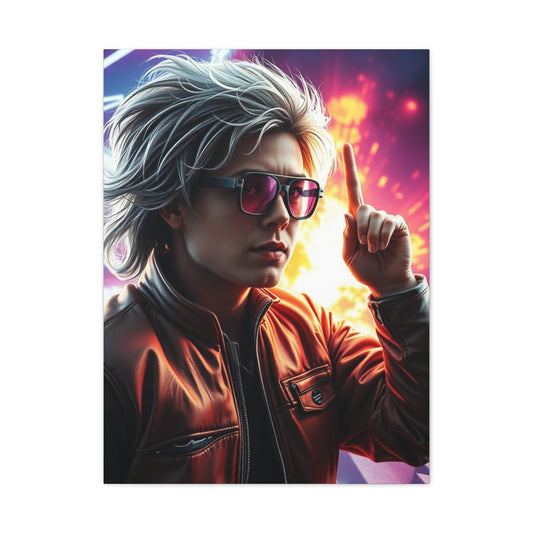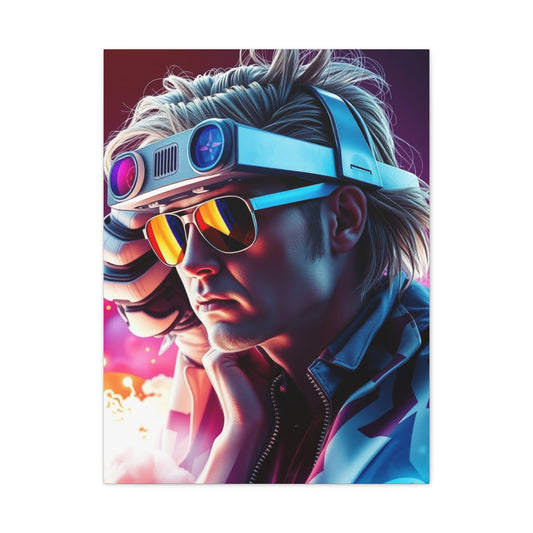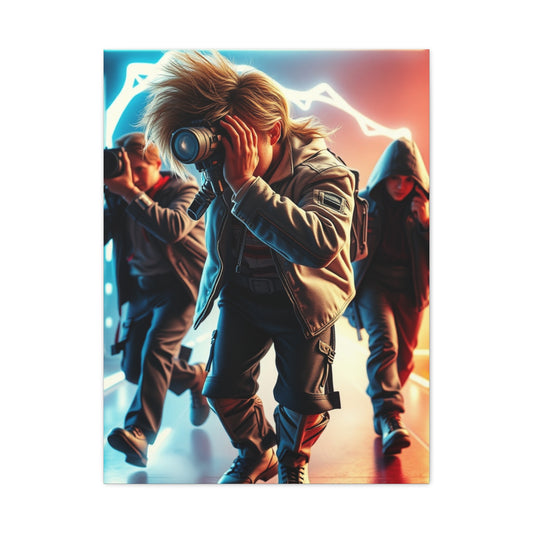The Rise of Back to the Future Wall Art and Parametric Design in Modern Interiors
In contemporary interior design, the integration of Back to the Future Wall Art and parametric wall designs represents a shift from traditional décor toward immersive, interactive aesthetics. Unlike conventional artwork, which often functions as a passive backdrop, these innovative creations combine algorithmic precision, artistic vision, and modern fabrication techniques to craft pieces that actively engage with their surroundings. Homeowners and designers are increasingly embracing these forms to create spaces that are dynamic, customizable, and imbued with personal significance. Each installation transcends its role as mere decoration, becoming an evolving visual element that transforms the ambiance and character of a room.
Parametric wall art relies on the use of algorithmic frameworks to define form, structure, and spatial relationships. Designers employ specialized software to establish rules, constraints, and variables that guide the generation of complex geometries and textures. This approach allows for nuanced manipulation of shape, depth, layering, and dimensionality, producing designs that would be nearly impossible with traditional manual methods. By adjusting parameters, artists can produce bespoke wall installations that respond harmoniously to architectural features, ceiling heights, and even natural lighting, ensuring that each piece is uniquely adapted to its environment. From sweeping geometric panels in modern lofts to modular sculptural pieces in office spaces, the possibilities for creativity and personalization are virtually limitless.
The adaptability of parametric and Back to the Future-inspired designs makes them suitable for a variety of interior aesthetics. In minimalist apartments, a single parametric panel can serve as a dramatic focal point, introducing texture, movement, and rhythm to an otherwise understated space. The interaction with natural light enhances the perception of depth, creating shifting shadows that evolve throughout the day, adding a living quality to the design. In corporate environments, these wall installations can humanize expansive, open-plan layouts by providing visual intrigue while maintaining a professional atmosphere. Even in eclectic or traditionally styled interiors, these contemporary geometries can bridge disparate design elements, harmonizing modern patterns with classic textures to produce a cohesive and visually engaging narrative.
Beyond aesthetic considerations, parametric wall art emphasizes personal connection and storytelling. The creative process frequently involves collaboration between artist and client, ensuring that each piece reflects individual passions, hobbies, or life experiences. For example, a homeowner inspired by astronomy might commission an artwork based on orbital paths, celestial formations, or abstract cosmic patterns. Others may gravitate toward natural motifs such as fractal-like vegetation, waves, or topographic landscapes. This personalized approach elevates the artwork from decorative object to narrative medium, allowing spaces to convey identity, meaning, and emotional resonance.
Sustainability is also a defining feature of contemporary parametric wall art. Designers often use environmentally conscious materials, including recycled metals, sustainably sourced wood, and biodegradable composites, marrying innovation with ecological responsibility. Digital fabrication techniques minimize material waste while maximizing structural complexity, proving that cutting-edge design and sustainable practice can coexist.
Exploring the Principles of Parametric Design
At its core, parametric design is a confluence of mathematics, technology, and artistic creativity. Unlike traditional methods where each form is manually constructed, parametric approaches depend on relationships among lines, angles, curves, and proportions. Adjusting a single parameter can ripple across the entire composition, generating infinitely varied results while maintaining balance and coherence. This interplay of control and spontaneity produces works that are mathematically precise yet visually fluid, resulting in a captivating blend of logic and imagination.
Parametric wall art often appears organic despite its algorithmic origin. Metal sculptures may ripple and flow like water, interlocking shapes create dynamic shadows, and canvas prints showcase interwoven geometries that reveal new discoveries from each viewing angle. The careful tension between order and fluidity creates visual intrigue and encourages repeated engagement, transforming walls into interactive experiences.
Modern parametric designs also complement minimalism by exploring depth, curvature, and movement within defined constraints. Algorithm-driven patterns produce rhythmic sequences, fractal motifs, and repeating geometries that resonate with human perception of symmetry and balance. Intentional asymmetries, negative space, and subtle deviations prevent rigidity, allowing each piece to feel alive and responsive to the viewer.
Technological tools enhance creative potential by iterating numerous design possibilities that would be difficult to achieve manually. Designers set key variables, including spacing, rotation, repetition, and proportion, then fine-tune color, scale, and material for aesthetic impact. This fusion of computational precision and human intuition yields artworks that are at once engineered and expressive, seamlessly fitting into contemporary interiors that demand versatility and adaptability.
Patterns, Symmetry, and the Mathematics of Beauty
The fascination with parametric wall art extends far beyond mere decoration; it lies in the profound connection between mathematics, nature, and human perception of beauty. Parametric design uses algorithmic principles to generate patterns and forms that echo structures found in the natural world. From the spiraling shells of mollusks to the branching veins of leaves and the fractal intricacies of mountain landscapes, the underlying mathematics of nature provides endless inspiration for artists and designers. By translating these principles into wall art, creators produce pieces that are simultaneously visually compelling, intellectually stimulating, and emotionally resonant.
At the core of parametric wall art is the concept of pattern and symmetry, which humans instinctively recognize and respond to. Symmetry, in particular, is deeply ingrained in our perception of beauty. Studies in psychology suggest that symmetrical patterns are often associated with balance, harmony, and even notions of health and vitality. Parametric artists harness this instinctual response, creating compositions that appeal to the subconscious mind. Repeating geometric sequences, tessellations, and spirals generate a sense of rhythm and order, while subtle manipulations within these sequences can introduce complexity and intrigue. This interplay of predictability and variation keeps the viewer engaged, prompting closer observation and prolonged contemplation.
Parametric wall art is rarely purely symmetrical; in fact, intentional deviations from symmetry often enhance its allure. Small asymmetries, dynamic curves, and deliberate interruptions in patterning introduce tension and movement, transforming what might otherwise be static compositions into living, breathing visual experiences. Negative space—areas deliberately left empty—plays a critical role in this process, offering visual relief while accentuating the shapes and lines that surround it. The careful balance between filled and unfilled space allows the artwork to “breathe,” inviting viewers to navigate their gaze across the surface, discovering new relationships between elements with each look.
The mathematical principles behind parametric designs extend into various forms, each contributing to the piece’s aesthetic appeal. Fractals, for example, are recursive patterns that replicate themselves at different scales. These naturally occurring geometries—seen in ferns, snowflakes, and lightning—evoke a sense of infinite complexity and continuity. Golden ratios and Fibonacci sequences are other mathematical constructs that inform the proportions and spatial arrangements within parametric art, producing a harmony that feels intrinsically satisfying. When applied to wall art, these principles guide the positioning of shapes, curves, and lines, resulting in compositions that are both visually dynamic and subtly ordered.
Beyond their structural qualities, parametric artworks engage viewers emotionally. The human brain is drawn to patterns and rhythmic arrangements, often experiencing a meditative or contemplative state when interacting with such designs. A wall adorned with parametric patterns can thus become more than decorative—it transforms into a mental and sensory experience, stimulating curiosity and reflection. The mathematical elegance of these pieces bridges the gap between the rational and the aesthetic, allowing viewers to appreciate both the logic behind the design and the sheer beauty of its manifestation.
Parametric wall art also resonates across diverse interior styles. In minimalist spaces, geometric and algorithmic patterns can add depth and intrigue without disrupting simplicity. In eclectic or modern settings, fractal-inspired or spiral compositions provide a focal point that complements bold colors and textures. The flexibility of parametric design ensures that these artworks can adapt to various scales, mediums, and color palettes, making them versatile tools for both personal expression and spatial enhancement.
Personalization and Customization
One of the most compelling aspects of parametric wall art is its extraordinary potential for personalization and customization. Unlike traditional artwork that comes in standard sizes, designs, or mass-produced editions, parametric wall art offers homeowners the opportunity to create a one-of-a-kind visual experience tailored specifically to their space, tastes, and personal narrative. This shift from pre-designed prints to bespoke, interactive creations fundamentally transforms the role of wall art—from being a simple decorative element to becoming a deeply meaningful and expressive feature of a home.
Customization allows homeowners to infuse their personality into every aspect of the artwork. For example, someone passionate about astronomy can commission a parametric piece that mirrors the night sky at a particular time and place, incorporating constellations, planetary positions, or the subtle shimmer of stars. Similarly, a homeowner with a love for music could integrate visual interpretations of favorite compositions, translating rhythm and harmony into abstract forms and textures. Even architectural nuances, such as wall proportions, ceiling heights, or natural lighting conditions, can be taken into account, ensuring the piece not only complements but enhances the surrounding environment. This approach guarantees that every element of the artwork is intentional, fostering a sense of connection and belonging that standard wall décor rarely achieves.
Parametric wall art also empowers homeowners to make choices in material, texture, and finish, further enhancing personalization. From metallic sheens and wood grains to acrylic surfaces or fabric-based textures, the available options allow for intricate layering of aesthetic and tactile experiences. Patterns can be scaled, rotated, or repeated to harmonize with furniture arrangements, color palettes, or even seasonal décor schemes. The ability to adjust dimensions and proportions ensures the artwork fits seamlessly into spaces of any size, whether it’s a sprawling living room, a compact study, or an intimate hallway. This adaptability makes parametric pieces not only visually striking but also spatially intelligent, transforming the physical environment in subtle yet profound ways.
Moreover, the emotional resonance of customized wall art cannot be overstated. By incorporating personal stories, memories, or passions into the artwork, homeowners create pieces that evoke feelings of nostalgia, pride, or inspiration each time they are viewed. A parametric wall installation that references a memorable travel destination, a beloved hobby, or a family milestone transcends the purely visual experience, becoming a conversation starter and a repository of personal meaning. Unlike mass-produced prints, these works carry a narrative depth that grows richer over time, evolving alongside the lives of the people who inhabit the space.
Beyond personal expression, customization elevates the investment value of parametric wall art. Bespoke pieces are inherently unique, which enhances their desirability and long-term appeal. They are often regarded as collector-worthy items, blending artistry with functionality in a way that resonates with both homeowners and visitors. For interior designers, parametric wall art offers a versatile tool to meet clients’ specific needs while pushing the boundaries of conventional design. It can anchor a room, establish thematic cohesion, or act as a focal point that draws attention and admiration.
Integration in Contemporary Spaces
Parametric wall art has emerged as a transformative force in contemporary interior design, seamlessly merging advanced artistic innovation with architectural sophistication. In modern spaces where clean lines, open layouts, and minimalistic aesthetics dominate, parametric installations act as both visual anchors and dynamic conversational pieces. Unlike traditional artwork, which often serves a purely decorative function, parametric wall art engages viewers on multiple sensory and cognitive levels, inviting closer inspection and interaction. Its ability to adapt to the scale and rhythm of a room makes it particularly suited for contemporary homes, offices, and public spaces where spatial fluidity is prioritized.
Large-scale parametric panels are one of the most striking applications in modern interiors. These expansive works can dominate a feature wall or serve as room dividers, introducing a sculptural quality that bridges the gap between fine art and architecture. Multi-layered installations, often composed of interlacing geometric patterns or mathematically derived curves, create a sense of depth and dimensionality that traditional flat paintings cannot achieve. Modular designs further enhance adaptability, allowing homeowners or designers to rearrange components based on spatial requirements, seasonal themes, or personal aesthetic evolution. This modularity reinforces the parametric ethos of flexibility and responsiveness, turning static walls into ever-changing canvases.
The interaction of light with parametric surfaces is another defining characteristic that amplifies their impact in contemporary spaces. Reflective materials, perforated panels, and layered elements react dynamically to both natural and artificial light. As sunlight moves throughout the day, shadows stretch, compress, and intersect across the artwork, generating a constantly evolving visual narrative. Evening lighting can be strategically positioned to highlight specific contours, textures, or angles, transforming the installation into a luminous centerpiece that shifts in mood with the surrounding environment. This fluid interplay of light and shadow introduces rhythm and movement into spaces that might otherwise feel static or monotonous, fostering a living, breathing atmosphere within the home or office.
Parametric wall art also interacts thoughtfully with furniture and interior finishes. Minimalist furniture, characterized by neutral tones, sleek surfaces, and unobtrusive forms, serves as the perfect backdrop, allowing the complexity of the artwork to shine without overwhelming the space. Contrasting textures, such as matte wood or polished stone, further accentuate the sculptural qualities of the art, creating layered visual experiences that reward careful observation. Even open-plan spaces benefit from parametric installations, as they can delineate zones subtly, providing both structure and aesthetic intrigue without erecting physical barriers.
Beyond its aesthetic contributions, parametric art affects the psychological and emotional atmosphere of a room. Its intricate forms and flowing patterns engage the viewer cognitively, promoting curiosity and reflection. The repetition, symmetry, and controlled asymmetry inherent in many parametric designs tap into innate human preferences for balance and proportion, making spaces feel harmonious yet stimulating. The introduction of texture and depth counters the flatness of minimalist interiors, creating an immersive environment that invites people to linger, interact, and explore. In commercial or collaborative settings, such as offices, galleries, or co-working spaces, parametric wall art can even enhance creativity, foster conversation, and encourage mindfulness by providing an ever-changing visual stimulus.
In summary, the integration of parametric wall art in contemporary interiors goes far beyond simple decoration. Its large-scale, multi-layered, and modular designs anchor spaces visually while responding dynamically to light, scale, and spatial flow. By enhancing texture, depth, and rhythm, parametric art transforms minimalist interiors into engaging, interactive environments that stimulate both aesthetic appreciation and emotional response. In doing so, it bridges the worlds of architecture, design, and artistic expression, offering contemporary spaces a unique blend of sophistication, innovation, and experiential depth.
Harmonizing with Traditional Interiors
While parametric wall art is often associated with sleek, contemporary spaces, its versatility allows it to seamlessly integrate into traditional and rustic interiors. Contrary to the misconception that parametric design only suits minimalist or modern homes, the underlying principles of this art form—geometry, repetition, and controlled variation—can be applied to materials, textures, and patterns that evoke warmth, history, and heritage. By thoughtfully selecting materials and techniques, parametric installations can enhance classical environments, creating a bridge between modern innovation and timeless elegance.
One of the most effective ways to incorporate parametric wall art into traditional interiors is through material choice. Wood, metal, and stone—staples of classic interior design—can all be shaped, carved, or layered using parametric methods. For example, a wooden panel can be algorithmically carved to form intricate geometric patterns that echo historical motifs found in antique furniture or architectural moldings. Similarly, metalwork can be parametrically bent or perforated to create dynamic, flowing patterns that reflect the sophistication of wrought iron gates or vintage light fixtures. Stone, whether in the form of marble, slate, or limestone, can be digitally carved or arranged to produce rhythmically repeating patterns reminiscent of classical reliefs, columns, or mosaics. By choosing materials with natural textures and warm tones, the parametric designs maintain an organic and authentic presence in the room.
Texture and finish are equally important in harmonizing parametric art with traditional interiors. In rustic spaces, for instance, hand-finished or distressed surfaces enhance the tactile appeal of the installation, allowing it to feel as though it naturally belongs to the room rather than standing out as an artificial or purely technological construct. Matte finishes, subtle patinas, and carved reliefs can soften the geometric precision of parametric designs, providing a warm, approachable character that complements antique furniture, handcrafted cabinetry, and vintage décor. Even in grand classical interiors, parametric wall art can be designed with slight asymmetries or curvilinear forms that echo the ornate detailing of crown moldings, arches, and cornices, creating a sense of visual continuity.
Parametric wall art also opens new possibilities for spatial storytelling within traditional homes. Unlike conventional artwork, these installations can interact with the architectural features of the space. Panels can be designed to follow the curve of a staircase, accentuate the height of vaulted ceilings, or fill alcoves with dynamic, repeating motifs that draw the eye without overpowering existing design elements. By responding to the scale, proportions, and rhythm of the room, parametric pieces can enhance a home’s narrative, tying together classical furnishings, historic woodwork, or exposed brick walls with a fresh yet harmonious perspective.
Moreover, the adaptability of parametric art allows homeowners and designers to tailor the pieces to their aesthetic preferences and functional needs. For instance, carved wooden panels can serve as decorative screens that provide subtle separation between spaces, while metal installations can double as functional elements like lighting fixtures or acoustic panels. By merging functionality with artistry, parametric design ensures that traditional interiors remain livable and practical while embracing innovative aesthetics.
In essence, parametric wall art does not threaten the authenticity of a traditional home; instead, it revitalizes it. By carefully selecting materials, textures, finishes, and spatial configurations, these artworks create a dialogue between past and present, honoring the history of a space while introducing contemporary sophistication. Warm tones, natural textures, and meticulously crafted patterns ensure that every installation feels both intentional and timeless, transforming walls into canvases that celebrate both tradition and modern ingenuity.
By bridging the gap between classical charm and contemporary design principles, parametric wall art offers a unique opportunity for homeowners to create interiors that are visually captivating, emotionally resonant, and deeply personalized. It demonstrates that even in homes steeped in tradition, innovation can coexist gracefully, producing spaces that feel timeless yet fresh, familiar yet surprising, and ultimately, profoundly harmonious.
Expressing Passions Through Parametric Design
One of the most compelling aspects of parametric wall art lies in its ability to transform a living space into a reflection of personal passions and individuality. Unlike conventional wall decor, which often adheres to generic motifs or mass-produced designs, parametric art provides a framework for self-expression. By leveraging algorithmic processes, designers can craft shapes, patterns, and structures that resonate with the inhabitant’s experiences, interests, and emotional landscape, turning ordinary walls into meaningful visual narratives.
Homeowners can use parametric design to visually interpret their unique affinities and hobbies. For example, flowing, undulating panels may symbolize the gentle motion of ocean waves or the rhythm of a favorite river, evoking a sense of calm and continuity within the home. Similarly, sharp, angular, and spire-like structures can reference urban skylines or rugged mountain peaks, reflecting a love for architecture, exploration, or adventure. Even abstract geometries can carry personal significance, with curves, spirals, and grids representing concepts such as growth, connectivity, or creativity. This versatility ensures that every installation tells a story, one that is entirely specific to the individual and the environment in which it is placed.
Parametric wall art also enables dynamic storytelling through layers of complexity. Artists can manipulate depth, shadow, and repetition to create pieces that respond to changing light and perspective. As sunlight filters across surfaces or as viewers move through the room, patterns shift and evolve, creating an immersive experience that is both visually stimulating and emotionally resonant. This adaptive quality allows homeowners to curate a continually engaging environment that mirrors the ebb and flow of their own passions and moods.
Another key advantage of parametric design is the collaborative nature of its creation. Unlike off-the-shelf decor, parametric wall art often involves direct input from the homeowner. Designers and clients can work together to define the parameters, choosing forms, scales, and patterns that embody personal narratives. Whether it’s integrating motifs inspired by travel adventures, nature walks, or artistic pursuits, the final work becomes a co-created piece, imbued with layers of meaning and intimacy. This process transforms art from a passive decorative element into an active, participatory reflection of identity.
The psychological impact of such personalized installations should not be underestimated. Living in a space that is adorned with art representing one’s passions fosters a deeper sense of comfort, belonging, and inspiration. The visual presence of familiar themes and motifs can enhance daily well-being, evoke positive memories, and serve as a source of motivation and creativity. Walls that communicate identity encourage inhabitants to engage more deeply with their environment, cultivating a sense of mindfulness and connection within the home.
Moreover, parametric wall art opens doors for integration with multiple design styles and materials, making it a versatile choice for expressing passion across various interiors. Wooden panels with intricate layering can create warmth and texture in rustic or traditional spaces, while metal or acrylic constructions complement modern and minimalist aesthetics. Designers can even combine multiple materials and finishes to reflect multifaceted interests, allowing homeowners to celebrate diversity in their passions while maintaining aesthetic cohesion.
Adapting to Diverse Spaces
One of the most compelling qualities of parametric wall art is its remarkable adaptability. Unlike traditional decorative pieces, which often have fixed dimensions and rigid visual structures, parametric designs are inherently scalable and flexible. This means that whether a space is a sprawling living room, a compact city apartment, or a uniquely shaped architectural niche, parametric artwork can be tailored to fit seamlessly, maintaining both aesthetic balance and spatial harmony. This adaptability makes it an ideal choice for homeowners, interior designers, and architects seeking art that responds to the environment rather than dominating it.
The dimensions and proportions of a room play a critical role in how parametric artwork is perceived. Large open spaces with high ceilings benefit from expansive pieces that draw the eye upward, accentuating verticality and emphasizing grandeur. For example, a towering wall in a loft can host a sweeping parametric installation, where curves and geometric patterns ripple across the surface, guiding the viewer’s gaze and creating a sense of movement. Conversely, in smaller rooms or cozy apartments, parametric designs can be scaled down or condensed without losing their visual impact. Smaller compositions maintain clarity and rhythm, ensuring that the space feels thoughtfully curated rather than overwhelmed by oversized artwork.
Room layout and architectural features also influence how parametric art is integrated. A curved wall may inspire a design that follows its contour, creating a sense of cohesion and organic flow, while angular or segmented walls can host modular parametric panels that echo structural lines. Even unusual spaces, such as under staircases, alcoves, or transitional hallways, can be enhanced with parametric pieces, turning otherwise overlooked areas into visual focal points. This spatial intelligence ensures that each installation feels purposefully placed, harmonizing with its surroundings while retaining individuality and artistic impact.
Material selection and dimensionality further enhance parametric art’s adaptability. Metal panels, layered acrylics, or mixed-media installations can introduce depth and texture, responding to ambient light and shadows in ways that shift throughout the day. In tight urban apartments, reflective or lighter materials can create an illusion of openness, while in expansive rooms, matte finishes and large-format designs can add grounding presence. The artwork becomes more than decoration; it interacts with the space dynamically, responding to angles, sightlines, and lighting conditions to create a living, breathing visual experience.
Another advantage of parametric design is its versatility in style integration. Whether a home embodies contemporary minimalism, mid-century modern charm, or eclectic layering, parametric art can adapt to complement the environment. Neutral-toned installations can subtly enhance a serene palette, while bold colors and striking patterns can act as statement pieces that energize the room. The ability to scale, shape, and materialize the design in ways that align with both architecture and décor ensures that parametric wall art maintains relevance across diverse interiors and evolving aesthetic trends.
Sustainability and Material Innovation
In recent years, sustainability has emerged as a driving force in the world of design, influencing not only architecture and product development but also the realm of wall art. Parametric wall art, with its inherent reliance on technology and algorithmic design, is uniquely positioned to embrace eco-conscious principles while pushing the boundaries of artistic innovation. Beyond aesthetic appeal, these works of art are increasingly recognized as responsible choices that align with a growing global emphasis on environmental stewardship.
One of the most significant ways parametric wall art promotes sustainability is through material selection. Artists and designers are prioritizing responsibly sourced materials, ensuring that each piece reflects ethical and ecological awareness. Wood, for instance, is often harvested from certified sustainable forests, where logging practices maintain biodiversity and prevent deforestation. Recycled metals—ranging from aluminum to steel—offer a second life for materials that would otherwise contribute to landfill waste, while providing a sleek, modern finish that complements contemporary interiors. Biodegradable composites and eco-resins further expand the palette of possibilities, allowing creators to craft complex shapes and textures without leaving a lasting environmental footprint. By consciously selecting materials with a reduced ecological impact, parametric wall art integrates environmental responsibility directly into its aesthetic value.
Beyond the choice of materials, parametric design methods inherently reduce waste. The algorithmic nature of these creations allows designers to meticulously plan every curve, panel, and structural element before fabrication begins. By simulating the layout digitally, artists can optimize cuts and minimize excess material, reducing scrap and avoiding unnecessary overproduction. This approach contrasts sharply with traditional fabrication techniques, which often rely on manual trial-and-error methods that generate surplus waste. The precision afforded by parametric algorithms ensures not only cleaner production but also consistent quality, creating a win-win scenario for both sustainability and craftsmanship.
Moreover, parametric wall art encourages modular and adaptable designs, which further contribute to environmental responsibility. Many pieces are constructed in panels or segments that can be rearranged, expanded, or repurposed as tastes and spaces evolve. This flexibility extends the lifespan of the artwork, reducing the need for frequent replacements and lowering the environmental impact over time. By embracing modularity, parametric design aligns with circular economy principles, where longevity, adaptability, and reuse are central to sustainable practices.
Light, Shadow, and Dynamic Interaction
Parametric wall art stands apart from traditional flat artwork due to its remarkable capacity to engage with light, shadow, and spatial dynamics in ways that bring a room to life. Unlike paintings or standard prints that maintain a fixed appearance regardless of environmental conditions, parametric installations are designed with sculptural depth, layered geometry, and precise forms that respond to changing light throughout the day. This transformative interaction allows walls to evolve visually, creating a living artwork that shifts in response to both natural and artificial illumination, enriching the atmosphere of any interior space.
The interplay of light and shadow is central to the experience of parametric wall art. As sunlight filters through windows, angles and contours of the installation produce subtle, shifting patterns on the surrounding walls and floors. In the morning, gentle rays may highlight the upper layers of a design, casting elongated shadows that stretch across the room. By afternoon, when the sun’s position changes, the artwork can appear entirely different, with shadows shortening, intensifying, or intersecting in novel ways. Even under artificial lighting, strategic placement of LEDs, spotlights, or ambient sources can accentuate textures and create dramatic effects, transforming the wall into a dynamic visual performance. This constant evolution fosters a sense of wonder, keeping spaces engaging and preventing the monotony that can occur with static décor.
The sculptural elements of parametric art are deliberately crafted to harness this dynamic quality. Layers may be perforated, folded, or interwoven to manipulate light transmission, producing intricate mosaics of shadow that interact with movement within the room. This adds a temporal dimension to the artwork, allowing it to tell a subtle story as daylight shifts, clouds drift, or interior lighting changes. Walls cease to be inert backdrops; they become active participants in the ambiance of a home, responding organically to environmental stimuli and reflecting the rhythm of daily life.
In addition to visual intrigue, this light-shadow interplay enhances emotional resonance. Spaces infused with dynamic wall art feel more vibrant, alive, and immersive. Shadows can evoke calm and introspection when soft and diffused, or excitement and energy when sharp and dramatic. Homeowners often find that parametric installations influence mood subtly yet profoundly, providing an evolving backdrop for living areas, bedrooms, and creative studios. This interaction also adds a sense of scale and depth, particularly in rooms with limited natural light or smaller dimensions, as shifting shadows can visually expand the space and introduce complexity that engages the eye.
Choosing the Right Parametric Wall Art
Selecting the perfect parametric wall art for a space involves more than simply picking a visually appealing design. It requires a thoughtful approach that balances scale, material, pattern, and harmony with existing décor. Unlike conventional paintings or prints, parametric wall art functions as both an aesthetic centerpiece and an architectural extension, which means the process of selection should integrate artistic sensibilities with practical spatial considerations.
The first step in choosing a piece is identifying the wall or area that will serve as the focal point. This could be a large, uninterrupted wall in a living room, a feature wall in a bedroom, or even a partition in an open-plan space. Large installations naturally draw attention, providing a visual anchor around which furniture arrangements, lighting, and other decorative elements can be organized. For example, a multi-layered parametric panel spanning an entire living room wall can define the room’s character, giving it a sense of structure and rhythm while complementing minimalist furniture and neutral palettes. In contrast, smaller walls or narrow corridors may benefit from layered or modular designs that create the illusion of depth, adding sophistication without overwhelming the space.
Material selection is another crucial consideration. Parametric wall art is available in a wide array of mediums, each producing distinct visual and tactile effects. Metal panels, such as aluminum or titanium, reflect light dynamically, producing subtle shifts in tone as daylight changes throughout the day. Acrylic or glass components create transparency and layering effects, allowing portions of the wall or surrounding décor to remain visible while still contributing to the overall design. Wood, natural fibers, and composite materials can introduce warmth and texture, softening the geometric precision of parametric forms. Choosing the right material not only impacts visual appeal but also influences maintenance, durability, and the interaction of light and shadow within the space.
The complexity of patterns and forms is equally important. Parametric wall art ranges from delicate, flowing curves to bold, geometric grids. Symmetry and repetition can provide a sense of order and balance, making them ideal for formal or minimalist interiors, while controlled asymmetry adds dynamism and intrigue, encouraging the eye to explore the surface. When selecting a pattern, consider both the scale of the design and the size of the wall. Overly intricate patterns on a small wall can feel cramped, whereas large, sweeping designs on expansive walls can become mesmerizing focal points that enhance the room’s ambiance.
Lighting conditions play a pivotal role in how parametric wall art is perceived. Natural light can create shifting shadows and highlights across layered or perforated surfaces, bringing a sense of movement and life to the installation. Artificial lighting—spotlights, LED strips, or ambient uplighting—can be strategically positioned to accentuate textures and angles, highlighting specific details or creating a dramatic effect. Evaluating the room’s lighting conditions at different times of day ensures the chosen piece performs optimally under varying environments.
Layered Meaning and Conceptual Depth
Beyond physical form, parametric wall art allows for layered symbolism. Shapes, patterns, and repetitions can carry hidden narratives or personal significance. For example, spirals may symbolize growth or evolution, while interlacing grids can represent interconnectedness. These conceptual layers enrich the artwork, transforming it from mere decoration into an intellectually and emotionally engaging element of the home.
Parametric Wall Art as a Gift
The uniqueness and personal resonance of parametric designs make them exceptional gifts. Unlike conventional gifts, they offer lasting value, emotional significance, and artistic prestige. For housewarmings, weddings, anniversaries, or milestones, parametric art can capture the recipient’s personality, experiences, or dreams, ensuring a memorable and meaningful gesture.
The Future of Parametric Art in Interior Design
As technology and design continue to evolve, parametric wall art is poised to become a central pillar of modern interior decoration. Emerging fabrication techniques, AI-assisted design, and new materials promise even greater precision, sustainability, and creative freedom. Artists will increasingly blur the line between functional architecture and expressive art, transforming homes into immersive, dynamic environments. Parametric wall art is not merely a trend; it represents the future of personalized, adaptable, and meaningful design.
Conclusion:
In conclusion, the integration of parametric and Back to the Future Wall Art into contemporary interiors represents a profound evolution in design philosophy. These artworks are more than decorative elements; they embody interaction, narrative, mathematical sophistication, and environmental responsibility. By leveraging algorithmic design, artists can produce bespoke compositions that harmonize with architectural features, lighting, and spatial proportions, offering both aesthetic beauty and functional adaptability.
Parametric wall art enhances interiors by providing focal points that evoke curiosity and contemplation, balancing minimalism with expressive complexity. The interplay of patterns, fractals, and dynamic geometries creates a multisensory experience, encouraging viewers to engage with the space and appreciate its evolving qualities. Incorporating these designs into residential, commercial, or eclectic interiors elevates the atmosphere, offering both visual intrigue and emotional resonance.
Moreover, the sustainability inherent in contemporary parametric design highlights the potential to marry creativity with eco-conscious practice. Using recycled, biodegradable, and responsibly sourced materials ensures that modern aesthetics coexist with environmental stewardship. Personalization further amplifies the impact, as artworks can reflect individual interests, stories, or cultural motifs, transforming interiors into deeply meaningful environments.
The future of interior design is intrinsically linked with innovation, interactivity, and the fusion of technology with artistic vision. Parametric and Back to the Future Wall Art exemplify these trends, demonstrating that walls can serve as dynamic canvases where mathematical precision, narrative expression, and visual delight converge. In essence, these designs do not merely fill space—they transform it, turning ordinary rooms into extraordinary environments that resonate intellectually, emotionally, and aesthetically with those who inhabit them. By embracing these evolving forms of wall art, homeowners and designers alike can craft spaces that are timeless, sustainable, and uniquely reflective of their vision and creativity.












